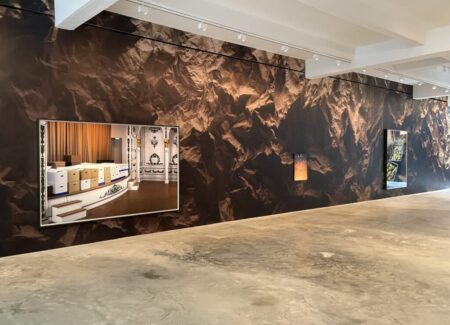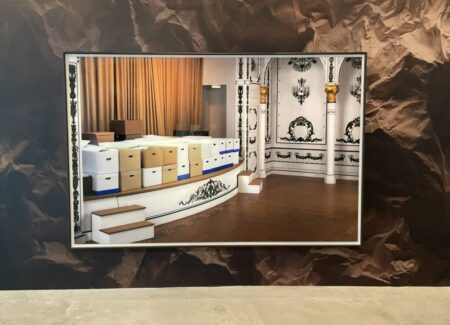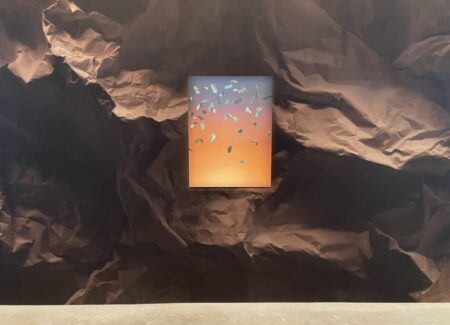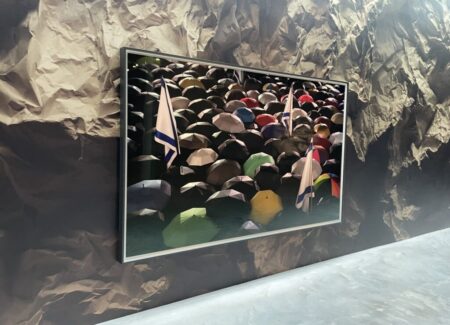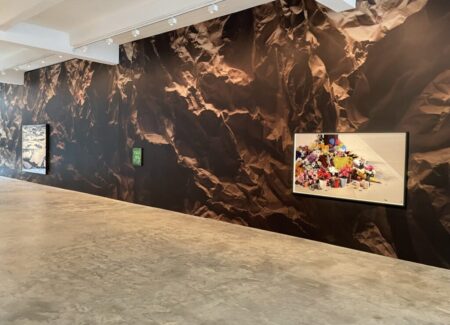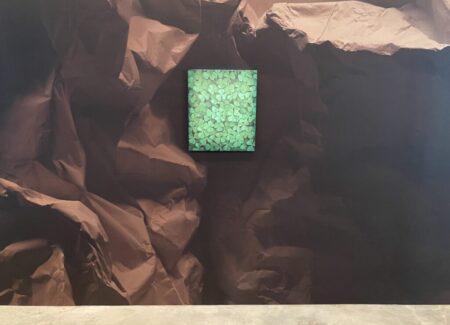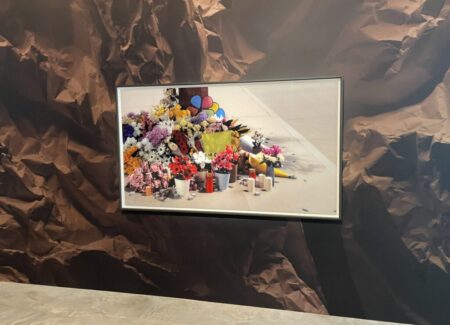JTF (just the facts): A total of 7 color photographs, framed in light grey and unmatted, and hung against artist-designed wallpaper in the main gallery space. (Installation shots below)
The following works are included in the show:
- 5 UV prints, 2023, 2025, sized roughly 97×72, 80×99, 80×122, 76×124, 48×82 inches, in editions of 6
- 2 UV prints on copper, 2025, sized roughly 34×25, 20×17 inches, in editions of 6
- 1 UV print on nonwoven wallpaper, 2025, dimensions variable
Comments/Context: For many successful artists in late middle age, say in their 50s and 60s, after a career retrospective or two at major institutions have celebrated their aggregate achievements, they reach a kind of power zone where they feel more confident and artistically secure than they did when they were younger, but not yet too old to take on even bigger ideas and challenges. And with this comfort (and external validation/recognition) comes the ability to work even more freely – with less to prove, an artist can often embark on new work that builds on earlier decades of learnings while taking on risks or extensions (in scale, scope, subject matter, and other parameters) that might have felt daunting or even impossible before.
The German sculptor/photographer Thomas Demand has certainly reached this enviable echelon of artistic maturity. While it’s been a handful of years since his last solo gallery show in New York (in 2018, reviewed here), Demand has kept busy with the 2019 publication of a full career catalogue raisonné (reviewed here), followed by a touring museum exhibition, now on view in Taipei, with previous stops in Shanghai, Paris, Jerusalem, and Houston. This gallery show essentially brings us up to speed on his current state of mind, sampling images made between 2023 and 2025.
Across Demand’s multi-decade career, the structural and conceptual framework of his work has remained remarkably consistent. Demand starts with a photograph, taken by him or otherwise sourced from the Internet, the news, or elsewhere, which he then uses as the reference image or blueprint to construct a paper model of that same scene (from the same vantage point), which he then photographs. Along the way, there is an intriguing set of translations taking place, from photograph, to paper model, and back again, with Demand interpreting the photograph to make the simplified model, and then interpreting the model to make the end-product photograph.
While Demand has often used images drawn from the headlines as his source material, he has generally been somewhat oblique about providing specific references to where these moments have come from, letting his process and aesthetics peel away some of the literalness of the transcription. This show is a bit more legible in this regard, anchored around four pictures with overt political themes, several of which can be readily identified.
One work takes as its subject one of the ballrooms at Mar-a-Lago where former president Donald Trump stored boxes of classified materials; Trump was indicted on charges of mishandling these documents and the source image was one of the pieces of evidence presented by the Department of Justice in the summer of 2023 (here). The picture Demand chose features stacked cardboard boxes sitting on the stage of a fancy golden ballroom, seemingly unguarded and haphazardly secure, which is what made the picture so stinging in the first place – if those boxes did hold top secret or classified materials, they certainly didn’t look vigilantly protected. There is a certain magic to the idea of Demand recreating this entire scene with his own cardboard, thereby conceptually nesting layers of cardboard representing cardboard, and the resulting image is simplified from the original, but altogether faithful in its overall descriptive truth. There is also a doubling of the stage set feeling, the room itself a kind of performance, which Demand has then re-performed, all the way down to its gilded capitals and golden drapery.
A second work is similarly drawn from current events, showing us bins of fake watermelons containing methamphetamine captured on the US-Mexico border in 2024 (here). Demand’s work faithfully recreates the setup, with the round melons piled up and ready for transport, the green color bands on the melons varied just enough to plausibly mimic their natural appearance. What’s smart about this image choice is that it gives Demand the conceptual twist of making fake cardboard melons which were also originally fake, doubling the layers of intentional illusionism and misdirection. It’s also an eye catching composition, which then offers resonances to the drug trade, meth addiction, and other cross border social issues.
Two other works reimagine moments of collective action. One takes a 2023 demonstration in Israel as its subject, where protestors were gathered in reaction to controversial legal reforms planned by the government (as seen here). It is a dense sea of umbrellas on a rainy night, interspersed with a few Israeli flags (which Demand has made more universal by removing the central logos, leaving only the blue stripes). Demand’s version of the moment captures a crowded sense of democratic spirit, while also reveling in the repeated facets of the umbrellas and the highlights that glance off them in the darkness. Another work moves in closer, to an improvised memorial of flowers, candles, and hand written notes placed on the sidewalk near an urban pole. While there is of course a specific moment that Demand had used as his inspiration, this image feels the most universal of such choices, abstracting the collective grief of any number of deaths and tragedies in cities around the globe every day.
The remaining works on view are less narrative driven and more directly textural. The strongest of these features cracked icebergs, with deep crevasses and hollows cut into the whiteness, revealing layers of ice like sedimentary rock. Here, the textures of Demand’s shaped paper match the eroded fissures with surprising fidelity, his approximation of the deteriorating ice offering an understatedly bleak view of its accelerating climate change-driven disappearance. Nearby, Demand’s smaller images of an all-over patch of green clover and cascades of falling green dollar bills abstract the familiar items down to their simplest elemental forms, the clover elegantly overlapped and layered like an intimate garden and the money turned into an exuberant confetti-like swirl. More expansive is Demand’s cave-like wallpaper that provides an enveloping backdrop for the show. His crumpled brown paper recreates the look and feel of craggy rock walls, successfully pulling us into the depths of its bumpy shadows and highlights, forcing us physically inside the confines of his fictional world.
While this show doesn’t find Demand taking too many unexpected risks, it’s clear that his mature style has solidified into something he can now deploy in a range of ways, from the modest to the monumental. If each of his subsequent shows boasts a few standout images (as this one does), Demand will continue to systematically increase his already impressive accumulation of photographic excellence, incrementally adding brick by brick to the wall of his already esteemed career.
Collector’s POV: The works in this show are priced between €35000 and €200000, based on size. Demand’s work is generally available in the secondary markets. Recent prices have ranged between $15000 and $415000 for the works in small editions (3, 5, or 6), while works from larger editions (100) have typically found buyers between $1000 and $5000.
